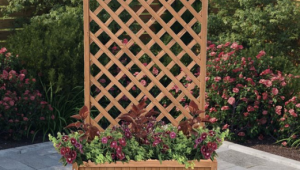Jump to:
Pressure treated sheds are an upgraded version of standard wooden garden storage. They can come as standard or customised, with a price tag that’s a little more than those untreated models. But are they worth the money? Here’s a quick run-through of the common questions so you know what you’re getting.
Should I Get My Shed Pressure Treated?
Yes, if you want your wooden shed to handle the weather better and last longer with less upkeep. It’s a good choice if you’re happy to pay extra and don’t mind the greenish tint finish.
What it means for the structure is that it already has a built-in layer of defence. You don’t need to treat it for several years, but you can feel free to paint it different colours once the treatment is dry.
And when you get a pressure treated shed, the manufacturer has done the work for you. It’s usually an option offered before you buy online or in-store. You can add it as an extra, and that’s where the additional cost comes in. Sometimes this means waiting a little longer for your building to arrive as well.
Don’t worry, though! Your initial investment will help you save money on maintenance and repairs in the long run.
What Is Pressure Treatment?

Pressure treatment involves placing cut and dried wood in an airtight steel cylinder. A vacuum removes the air, adds chemical preservatives, and extracts excess liquid. In this low-pressure environment, the wood absorbs the preservative deep into the grain.
This leaves a greenish tinge finish, which is their trademark. If you see a model in this colour, chances are it’s pressure treated. This also means the wooden shed has already been impregnated before it reaches you. It can cost more and take longer to deliver, but you’re getting a built-to-last one.
Note: The alternative to this process is to use paint or stain on your shed which contains wood preservatives. But this does not provide as strong or deep protection.
What Chemicals Are Used in Pressure Treated Sheds?
The greenish tint comes from copper compounds like copper azole and DCOI. These act as fungicides and insecticides. With this additional protection, you won’t have to worry about pests causing havoc.
Alkaline Copper Quaternary (ACQ) preservatives are another compound used for anti-decay. It’s water-based, which helps improve the wood structure’s water resistance.
Is pressure treatment harmful?
Generally, no. Pressure treatment chemicals are regulated and safe for handling. Freshly pressure-treated timber can cause skin irritation, but manufacturers generally allow it to dry beyond this point before supplying it to customers.
How Long Does a Pressure Treated Wooden Shed Last?
With resistance to rot, moisture, and pests, the shed’s durability and longevity can extend up to 25 years. Even longer in some cases, provided it’s properly cared for.
The anti-rot and pest infestation guarantee on pressure-treated sheds can vary. BillyOh, for instance, offers 15 years for pressure-treated models, including log cabins. Be sure to look at the product design details when browsing online.
To What Extent Is Pressure Treated Wood Waterproof?
The treatment helps repel water but is not strong enough to make the wood fully resistant. It can withstand dribbling water on its surface or a quick rinse from a hose for maintenance. Yet exposure to high humidity and prolonged rain is a different matter.
For instance, contact with pooling water can trigger fungal decay, leading to mould. And don’t ever think about submerging decking or fencing boards. The pressure treatment could be rendered ineffective against rot if left exposed, let alone covered by it, for long periods.
Pressure treatment helps protect the shed from the effects of normal wet conditions. However, that doesn’t mean you can soak it through and let it stay wet.
How Low-Maintenance Pressure Treated Sheds Are?
Pressure-treated sheds are much easier to look after. You won’t need to apply wood preservatives, stains, or coatings as often—or at all, depending on the guarantee. This reduces the need for regular upkeep and cuts down on long-term maintenance costs.
When Can I Paint My Pressure Treated Shed?
You may have to wait for about 3 to 4 months or longer during winter, up to 6 months, for the moisture levels to drop. Let the wood be once the shed is installed in your garden, then give it a moisture test after a few months.
Do so by sprinkling some water on the surface. If the water soaks into the wood, it’s ready to coat. It needs more time if the water beads up and won’t saturate.
What Makes Them So Expensive?
The initial cost covers the treatment process, which the manufacturer handles. Chemicals are injected under pressure or in a special vacuum—not to mention the effort to do so. That’s why you’ll often see an additional charge for this option (if it’s added as an upgrade) when checking out.
You might pay a bit more upfront, but you won’t be shelling out for extras later. Plus, you won’t need to do any treating yourself for several years.
It’s worth considering getting your shed pressure treated to enjoy long-term value. But remember, just because it requires less upkeep doesn’t mean you don’t have to take care of it. Get some ideas here: Ultimate Yearly Shed Maintenance Checklist













What do you think ?